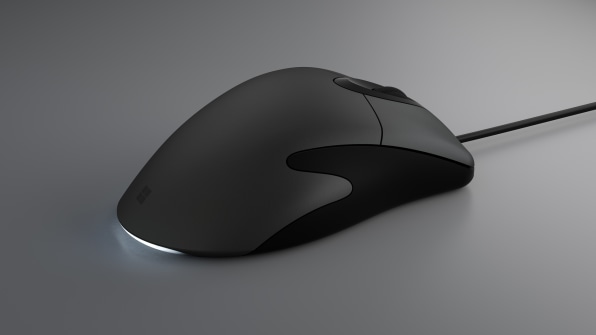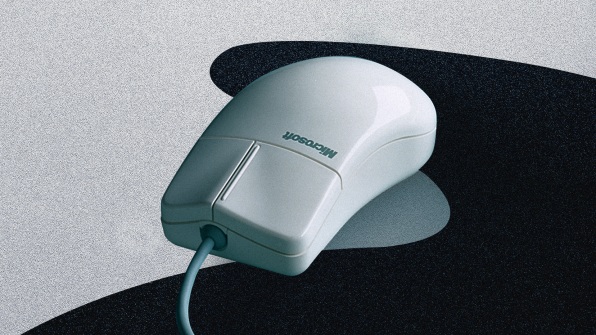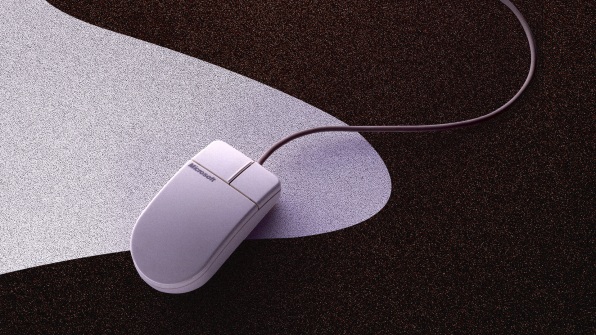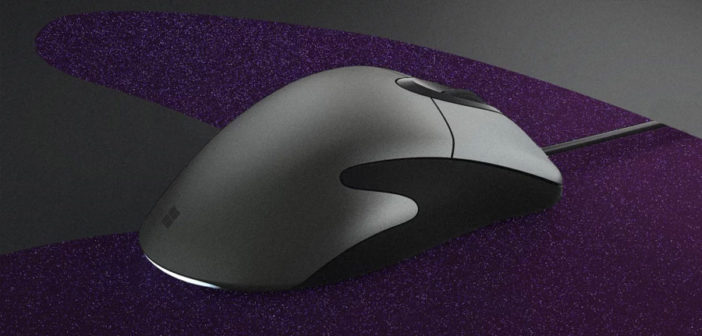Microsoft tried to kill its familiar corded IntelliMouse Explorer years ago. But the most discerning pointing device users on the planet weren’t willing to give it up.
When Microsoft released its first mouse in 1983, neither Apple’s Macintosh nor Microsoft’s own Windows had yet hit the market, which made the whole concept slightly futuristic–even though computing visionary Douglas Engelbart had invented the rolling pointing device nearly two decades earlier. Soon enough, mice became familiar. And new Microsoft mice have appeared ever since, refining the ergonomic experience and incorporating new technologies such as optical sensors and wireless connectivity as they came along.
Recently, however, Microsoft did something unexpected: It introduced a mouse whose selling point is that it’s based on old-school design and technology. A revival of 2003’s IntelliMouse Explorer 3.0, which the company last sold in 2012–-and which was itself an updated version of a design that dated to 1996–-the new $40 Classic IntelliMouse has a look that’s familiar rather than fresh, and connects to a PC via a USB cable rather than Bluetooth. Though it carries the current Microsoft logo, you might well take it for an antique on first glance.

Microsoft design director Simon Dearsley calls the original IntelliMouse Explorer 3.0 “the high watermark in the IntelliMouse series,” which is a startling thing for a tech executive to say about a 15-year-old product. (Try to imagine anyone from Apple saying that any iPhone other than the new iPhone was the best ever.) But a lot of people agree with him, which is why the Classic IntelliMouse’s release is a response to market demand rather than an act of pure nostalgia.

MOUSE EVOLUTION
The long history of Microsoftian mice is full of reminders that nearly all progress in the tech industry is about small changes that add up over time. The company shipped its first mouse in 1983 in hopes of speeding along the industry’s transition from text-based operating systems like MS-DOS to graphical user interaces; it was blockier than any modern model and had green, sliver-like buttons mounted on the front. It continued with variations on this basic design through the decade.
By the time Windows 3.0, the first widely used version of the software, arrived in 1990, Microsoft had created an all-new mouse in collaboration with a design firm which later merged with two others to become Ideo. That model moved the rolling ball that tracked your movement toward the front for better precision; made the buttons much larger; and introduced a more comfortable wedge shape. It was nicknamed the “Dove Bar” mouse, a moniker that I always assumed was inspired by the ice-cream treat, but Dearsley (and old computer magazine articles) says that actually referenced the soap.

In 1993, that design gave way to the Microsoft Mouse 2.0, which was crafted by Carl Ledbetter and Steve Kaneko, both of whom are still on Microsoft’s design team today. The result of a $10 million, two-year investigation into pointing-device ergonomics, the new model had a kidney bean-like silhouette meant to make it easy to plop your palm on top and rest your thumb on the side.Which leads me to a necessary disclaimer: As a southpaw who moused with my left hand, I was dismayed to see Microsoft release a mouse clearly sculpted for right-handed use, even though the company claimed it was equally comfy in the left hand. It helped sour me on the whole idea of mice, and I tended to use an ambidextrous trackball thereafter. Most IntelliMouse models, including the new one, have descended from the Microsoft Mouse 2.0, which is why I write about the Classic IntelliMouse not as an IntelliMouse enthusiast but as a detached bystander. (Microsoft does currently offer several mice that work equally well in either hand.)
Okay, end of digression. 1996’s IntelliMouse was even swoopier than the Microsoft Mouse 2.0, but its signature feature was the scroll wheel nestled between its buttons. It wasn’t the first mouse with a scroll wheel, but it popularized the technology–in part because Microsoft made it instantly useful by incorporating support for it into Office apps such as Word and Excel, allowing users to zip and zoom through documents. And at 1999’s COMDEX Spring trade show, the company released the original IntelliMouse Explorer. It ditched the pointing device’s rolling ball for a far more precise optical sensor, a technology that had been around for years but formerly required the use of a special mousepad. The Explorer also placed two customizable buttons within easy reach of your thumb, assuming you were a right-mouser.

As introduced in the first IntelliMouse and polished in subsequent generations, this design particularly appealed to people who were doing more ambitious things with their mice than occasionally jostling a cursor around in a word processor. “You have this distinctive swoop on the side that catches your third finger,” Dearsley says. “That makes it really comfortable for using all day long, because it puts your hand in a slightly turned-out, neutral position. You don’t need to grip it to reposition it and to move it around, so lifting it off the table for really quick repositioning is really easy. You don’t get hand fatigue.”Two years after releasing the original IntelliMouse Explorer, Microsoft introduced a version that ditched its cable for wireless technology. But it continued to sell the corded one as well, introducing version 2.0 and then 3.0. It eventually discontinued the latter version, brought it back due to popular demand in 2006, and then discontinued it again in 2012–not because consumers didn’t want it, Dearsley says, but because the STMicroelectronics sensor it used to track its movements went out of production. (There was also a version 4.0, with a spruced-up industial design and a scroll wheel that could tilt–but it wasn’t as popular as version 3.0, which outlived it.)

STILL USEFUL AFTER ALL THESE YEARS
Mice, which started out as a novelty and became a necessity, have entered a third stage of gadgethood: optional equipment. Sales of laptops eclipsed those of desktop PCs well over a decade ago, and every laptop has a built-in pointing device in the form of a trackpad. Still, a mouse is a nicety that many people find . . . well, nice. In an utterly unscientific poll of my laptop-using Twitter followers, almost half said they use a mouse at least some of the time.
Among the mouse’s most ardent fans are gamers, who almost universally find it to be the most swift and precise way to interact with fast-paced games such as first-person shooters. Gamers cherish the responsiveness of physical mouse buttons–the more the better–over the simulated mouse clicks offered by trackpads. They also prefer good old-fashioned corded mice to Bluetooth ones, in part to avoid the risk of even the slightest lag or the battery conking out mid-game. In addition, corded mice weigh less than their Bluetooth brethren, making them more agile: “If you’re making a lot of small and rapid movements, it’s really a big advantage,” Dearsley says.

For some of the same reasons, he adds, many professionals who spend all day doing precision work such as photo editing and computer-aided drafting are also wired-mouse devotees.
It was these demanding traditionalists whom Microsoft had in mind when it decided to revive the IntelliMouse Explorer as the Classic IntelliMouse. The new model, which debuted in October, brings back the IntelliMouse Explorer 3.0 industrial design of yore in slightly tweaked fashion: It sports a new two-tone gray color scheme, and the flashy red LED on the old version’s rear end has been replaced with a more tasteful white one on its undercarriage. But the company hasn’t tampered with the circa-2003 swoopiness and button positions.
It’s the new IntelliMouse’s guts, however, which make it an object of some controversy in the PC gaming community. Serious gamers, it turns out, evaluate mice much the same way they evaluate PCs: What’s inside matters at least as much as aesthetics. And game fans were awfully impressed with the responsiveness of the STM sensor that the previous IntelliMouse used, and skeptical about its replacement from a company called Pixart. One forum has a thread on the Classic IntelliMouse that runs to 40 pages of heated debate; some participants report that they like the Classic IntelliMouse while others say that the absence of the original STM sensor defeats the whole purpose of the revival.
Whatever the fate of the Classic IntelliMouse, “that underlying geometry that catches your hand has become the default shape and architecture for pretty much every single gaming mouse on the market,” says Dearsley. “All of the Razers, all of the Logitech gaming mice, all of the significant Chinese and European gaming mice all basically trace their legacy, their DNA, back to the shape that was created for the IntelliMouse 3.0.” Even Microsoft’s wireless, stylish Surface Mouse, designed to complement the company’s forward-thinking Windows tablets, recognizably riffs on the basic IntelliMouse design. It’s a quietly significant contribution to the way people interact with computers, and it’s likely to endure as long as the mouse itself does.
–
This article first appeared in www.fastcodesign.com
Seeking to build and grow your brand using the force of consumer insight, strategic foresight, creative disruption and technology prowess? Talk to us at +9714 3867728 or mail: info@groupisd.com or visit www.groupisd.com




